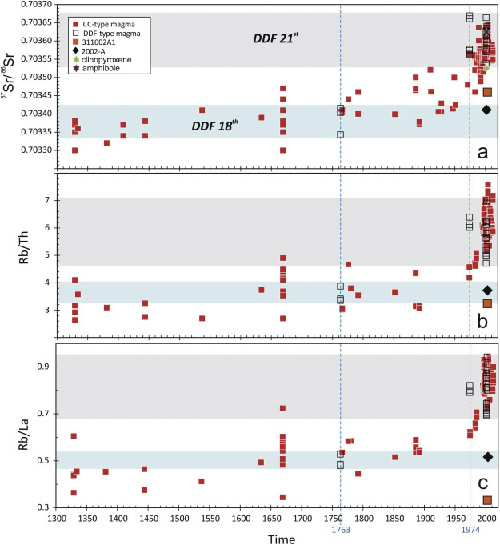Long and short-term magma differentiation at Mt. Etna as revealed by Sr-Nd isotopes and geochemical data

Di Renzo V., R.A. Corsaro, L. Miraglia, M. Pompilio, L. Civetta (2019).
Earth-Science Reviews, 190, 112-130, https://doi.org/10.1016/j.earscirev.2018.12.008.
Abstract
Mt. Etna, in Sicily (Italy), produces effusive and explosive eruptions from summit craters and flanks. Petrology of erupted products has proved fundamental to explore the relationship between magma dynamics within the plumbing system and eruptive styles. Data of SrNd isotopes are quite scarce if compared with the great number of chemical analyses carried out in products of last decades. We measure SrNd isotopes, major and trace elements in products emitted from 2001 to 2012, and consider also published analyses of the 1995–2001 eruptions, because carried out in the same laboratories of 2001–2012 ones. Furthermore, we take into account other published analyses extending back to the 14th century, even if performed by different facilities. Based on this dataset, magma dynamics operating at different timescales inside the volcano’s plumbing system have been explored. Our analyses evidence that, from 2001–2012, three magma types are present in the volcano’s plumbing system: (i) a deep and poorly evolved basaltic and K-trachybasaltic magma, enriched in radiogenic Sr and LILE, erupted during the 2001 and 2002–03 flank activity; (ii) a shallower more evolved K-trachybasaltic magma, less enriched in radiogenic Sr, feeding both summit and flank eruptions and (iii) an uncommon, and scarcely radiogenic hawaiitic magma, LILE poor, emitted exclusively from a small sector of the 2002–03 eruptive fissures. By considering a broader time scale, from 14th to 21st century, we conclude that: (i) different magmatic components are present in the deep volcano’s plumbing system, at about 10–12 km b.s.l; (ii) a decoupling of geochemical and isotopic features in magmas stored at different depths is observed after the 1974 flank eruption up to date; (iii) mixing between different magmas is an efficient magmatic process to produce magma differentiation at Mt. Etna, regardless of the investigated temporal scale.


Devi effettuare l'accesso per postare un commento.